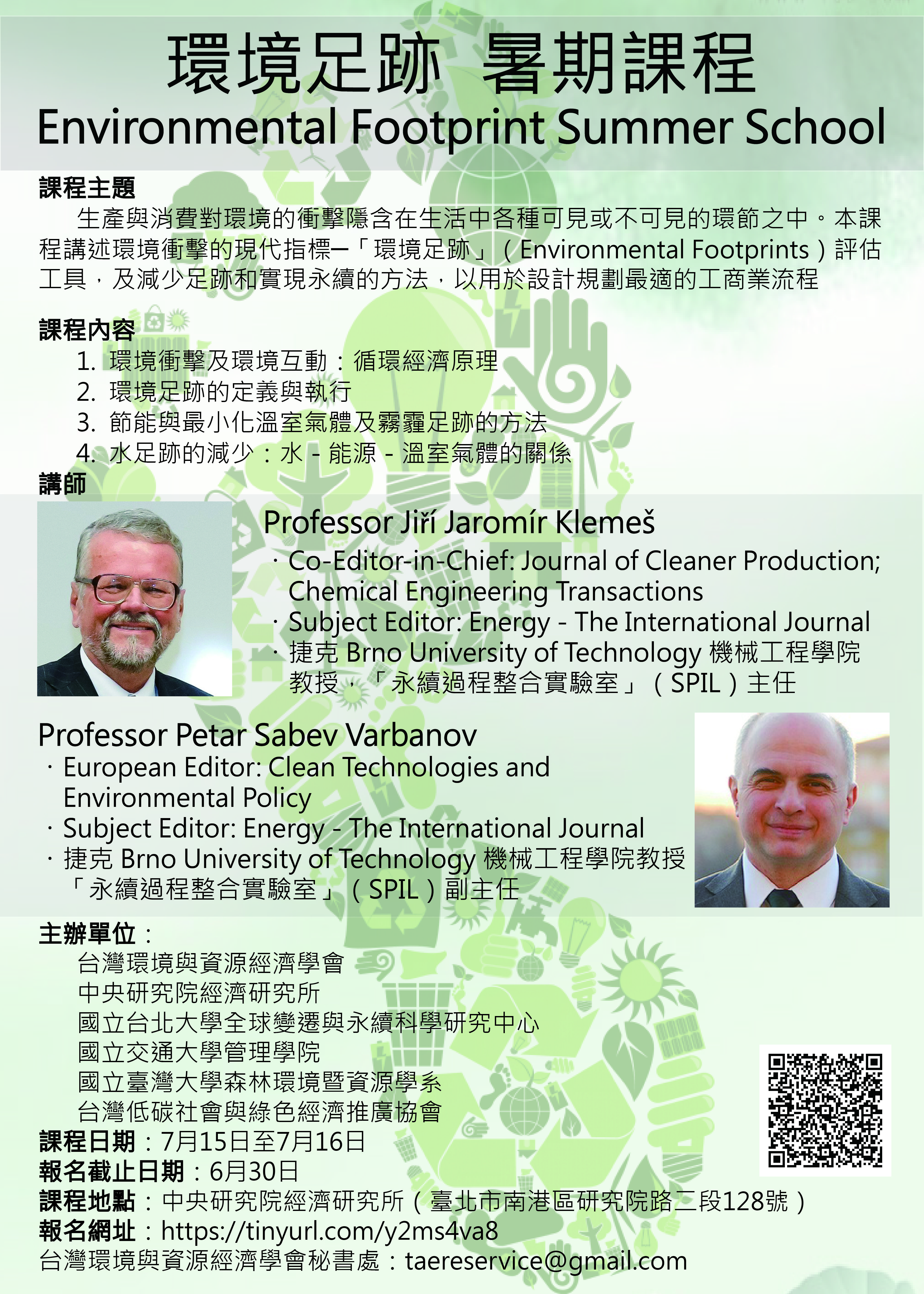
July 15-16, 2019
Organizers:
- Taiwan Association of Environmental and Resource Economics
- Institute of Economics, Academia Sinica
- Center for Global Change and Sustainability Science, National Taipei University
- College of Management, National Chiao Tung University
- School of Forestry and Resources Conservation, National Taiwan University
- Taiwan Association for Low Carbon Society an Economy
Venue: Institute of Economics, Academia Sinica, 128 Academia Road, Section 2, Nankang, Taipei, Taiwan
DEADLINE FOR APPLICATION: June 30, 2019
 |
|
 |
Professor Petar Sabev Varbanov
|
Abstract
The course offers an overview of the modern metrics of environmental impact, called "Environmental Footprints," and the methods for their reduction and achieving sustainability. Environmental Footprint assessment tools are very useful for optimising the performance of industrial and business processes. Often they are also referred to as "Ecological Footprints."
The course has several major parts:
Part 1. Introduction to environmental impacts and interactions, foundations of Circular Economy
This part introduces the topics, starting from a discussion of the main issues and problems of environmental pollution and depletion of natural resources from their natural storages. The emphasis is put on the need for circularity of the resource use and product/by-product reuse, and implementing the Circular Economy principles and strategy, to minimise resource extraction and waste discharge.
Definitions of sustainability and sustainable development are given. The Life Cycle thinking and the fundamentals of Life Cycle Analysis (LCA) are introduced, distinguishing between direct, indirect and total effects. The part includes the Environmental Performance Strategy Map – a concept that allows visualising and simultaneously optimising the environmental and economic performance indicators of human activities – an industrial site or other business activities.
The part concludes with the main principles and indicators important for measuring environmental impacts.
Part 2. Environmental Footprints – Introduction, definitions, implementation
This part introduces in more detail the key footprints, important for evaluating and altering the performance of industrial, business and societal systems in terms of environmental impacts and sustainability. The indicators include those for Greenhouse Gas (GHG), Water Footprint, Nitrogen Footprint, and others. The part concludes with presenting the possible measures and degrees of freedom to reduce footprints.
Within that context, the global energy and water flows are overviewed, including the flows of Virtual Water and Virtual GHG Footprints.
Part 3. Methods for Energy Saving and GHG and Haze Footprint Minimisation
This part starts by discussing case studies that provide examples of the benefits from concerted strategies for Energy Saving and further measures for GHG/Haze Footprint minimisation. The Process Integration principle is explained, clearly showing its coherence with the resource/waste hierarchy and the use of renewables as a footprint reduction tool. That is followed by the concepts, principles, and methods of Heat Integration and Pinch Analysis, for the simultaneous reduction of footprints and resource intake. The techniques include Data Extraction, Heat Recovery Targeting, Design of Heat Exchanger Networks, integration of energy-intensive processes, Total Site Heat Integration, Advanced Process Integration Techniques and energy storage methods, for improving the energy savings.
Part 4. Reduction of Water Footprint, Water-Energy-GHG Nexus
This part provides an introduction to Water Integration and nexus considerations. It starts with Data Extraction concerning water use, Water Network Design, discussion of water quality issues and implications, Water Pinch Analysis, water system analysis, Maximum Water Recovery Targets, design of Water Reuse Networks. Further techniques are discussed – the "Source/Sink Composite Curves" method for water targeting, the significance of the Water Pinch, Cost-Effective Minimum Water Networks – design and retrofit.
Further, the Water-Energy Nexus for industrial sites is considered, giving a case study for using the Nexus as a synergy mechanism for energy and water demand reduction.
Recommended literature
- Klemes, J. J. (Ed.). (2015). Assessing and measuring environmental impact and sustainability. Butterworth-Heinemann.
- Klemeš, J. J., Varbanov, P. S., Alwi, S. R. W., & Manan, Z. A. (2018). Sustainable Process Integration and Intensification: Saving Energy, Water and Resources. Walter de Gruyter GmbH & Co KG.
Participation fee
The fee covers lecturer expenses, downloadable course material, morning and afternoon teas, and two lunches and one dinner included in the School programme. It does not cover accommodations.
- TAERE members: Free of charge (to become a member)
- Non-members: The participation fee is 100 USD (or 3,000 TWD) per person for non-members.
Course outline. Here
Summer School Program. Here
Information on how to apply are available on the Summer School website.
Chinese website. Here
Summer School Secretariat: Email住址會使用灌水程式保護機制。你需要啟動Javascript才能觀看它
